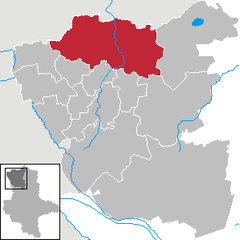Salzwedel
Salzwedel | |
|---|---|
Location of Salzwedel within Altmarkkreis Salzwedel district  | |
| Country | Germany |
| State | Saxony-Anhalt |
| District | Altmarkkreis Salzwedel |
| Government | |
| • Mayor | Siegfried Schneider |
| Area | |
| • Total | 106.66 km2 (41.18 sq mi) |
| Elevation | 19 m (62 ft) |
| Population (2022-12-31)[1] | |
| • Total | 23,543 |
| • Density | 220/km2 (570/sq mi) |
| Time zone | UTC+01:00 (CET) |
| • Summer (DST) | UTC+02:00 (CEST) |
| Postal codes | 29410 |
| Dialling codes | 03901 |
| Vehicle registration | SAW |
| Website | www.salzwedel.de |
Salzwedel (IPA: [ˈzaltsveːdəl]) is a town in Saxony-Anhalt, Germany. It is the capital of the district (Kreis) of Altmarkkreis Salzwedel, and has a population of some 21,500.
Geography
Salzwedel is situated at the Jeetze river in the northwestern part of the Altmark. It is located between Hamburg and Magdeburg. Distances from Uelzen are 44 km W, 12 km N of Lüchow, 41 km S of Gardelegen and 24 km E of Arendsee. In 1968 test drillings reveal a significant reservoir of natural gas near the city.
History
The town was founded in 1112. In medieval ages the town belonged to the Hanseatic league from 1358 to 1518. The city from 1247 began developing as a reestablishment from the old part of the town. In 1713, the two cities became one. In 1870 it received a railroad connection. The medieval part of the town remains the commercial and administrative center of the town until today.
As in other German cities during the reign of the NSDAP under Adolf Hitler, the Jewish segment of the population of the city was systematically disowned and driven out of the city.

In 1943, the Neuengamme concentration camp built a female subcamp in Salzwedel, capable of holding more than 1,000 female prisoners. Eventually more than 3,000 women were held there, both Jews and non-Jews. The guard staff at the camp included sixty SS men and women. One Aufseherin is known today by name, Lieselotte Darnstaedt, who was born in 1908. Lieselotte also served at Ravensbruck before coming to Salzwedel. On April 29, 1945, the US Army liberated the Salzwedel women's subcamp, and also a men's camp nearby for male non-German political prisoners. They were shocked to find more than ninety corpses of women who had died of typhus, dysentery and malaria. At the beginning of 1945, prior to the arrival of American ground forces, Allied war planes attacked the main train station of Salzwedel, killing 300 people. The US Army eventually turned over control of the city to the Soviet Army , causing Salzwedel to eventually become part of the GDR. On November 9, 1989 the East-West German border crossing near Salzwedel was openend , along with East-West border crossings in the rest of the country, allowing East Germans residing in Salzwedel and elsewhere to travel freely to West Germany for the first time since the building of the Berlin Wall. In 1990 Salzwedel received its first democratically elected city government.
Culture and Sights


This section needs expansion. You can help by adding to it. |
Main Sights
Salzwedel's sites of interest include the historic part of town, encompassed by the historic city wall and town gates. The city also contains the birth house of Jenny von Westphalen, later the wife of Karl Marx.
- numerous half-timbered houses
- town gates (Neuperver Gate, Stonegate) and medieval city fortifications
- remains of a castle (Castle Tower and Garden)
- Townhall (former monastery)
- Townhall Tower
- The Monk Church
- gothic Brickchurches St.Marien, St.Katharina und St.Lorenz
- another churches: St. Georg and Holy-Spirit-Church
- former Townhall, today's local court of Salzwedel
- Fairy-Tale Garden
- Johann-Friedrich-Danneil-Museum
- "Baumkuchen" Bakeries
Festivals
- Parkfestival, music event taking part in a 2-year-rhythm with the participation of national and international artists like Die Prinzen, Nina Hagen, Joe Cocker, Reamon, Heatha Nova, Leningrad Cowboys, Madsen, Blackmail, City and so on.
- Smack-Festival, one of the biggest Hard-Rock-Festivals in Saxony-Anhalt.
Regional Food
The delicacies of the town are Baumkuchen, Salzwedeler (Altmärker) Wedding-Soup and Tiegelbraten (mutton).
Transportation
Salzwedel is accessed by route 71 (north to south) and 248 (west to east). Access to the nearest autobahn is A39 which is 59 km away in Wolfsburg, the A250 is 80.9 km away in Lüneburg, the A24 in Dreieck and the A241 is 81.4 km away. It is linked by a railway which Amerikalinie (America Line) which restored in the 1990s linking Berlin and Bremen. The line belongs to Stendal/Uelzen. Other stations in Wittenberge near Arendsee and in Oebisfelde.
Twin Towns
 Wesel, Northrhine-Westphalia, since 1990
Wesel, Northrhine-Westphalia, since 1990 San Vito dei Normanni, Italy, since 1990
San Vito dei Normanni, Italy, since 1990 Felixstowe, UK, since 1994
Felixstowe, UK, since 1994
External links
- Homepage of Salzwedel (in German)
- ^ "Bevölkerung der Gemeinden – Stand: 31. Dezember 2022" (PDF) (in German). Statistisches Landesamt Sachsen-Anhalt. June 2023.

